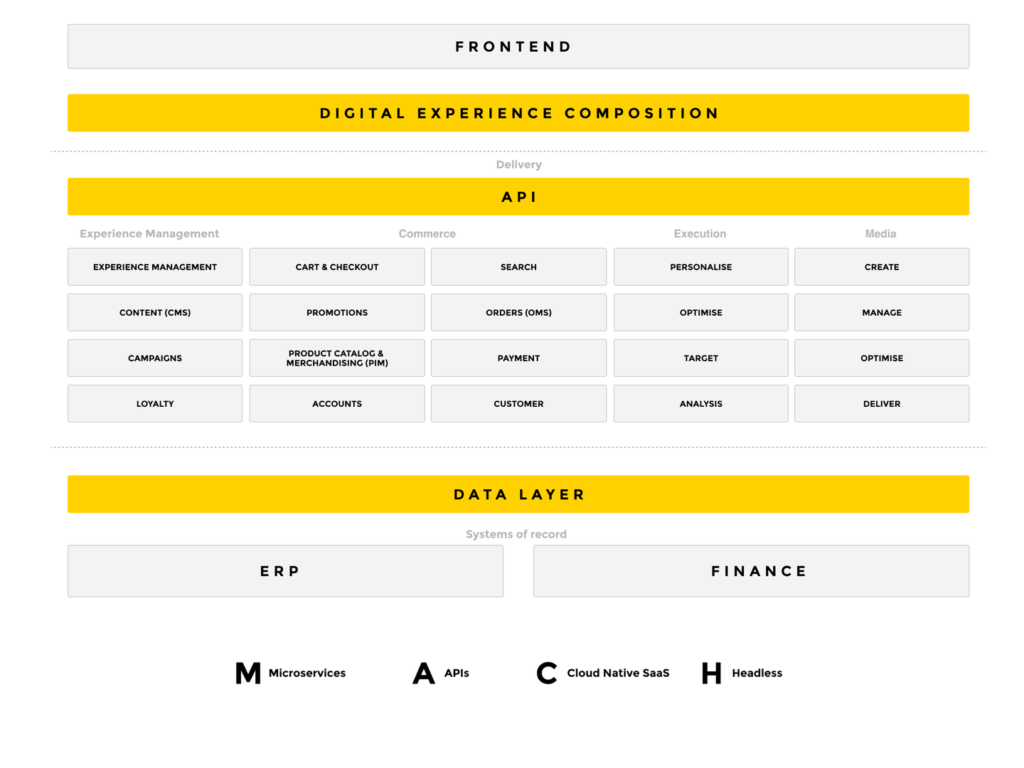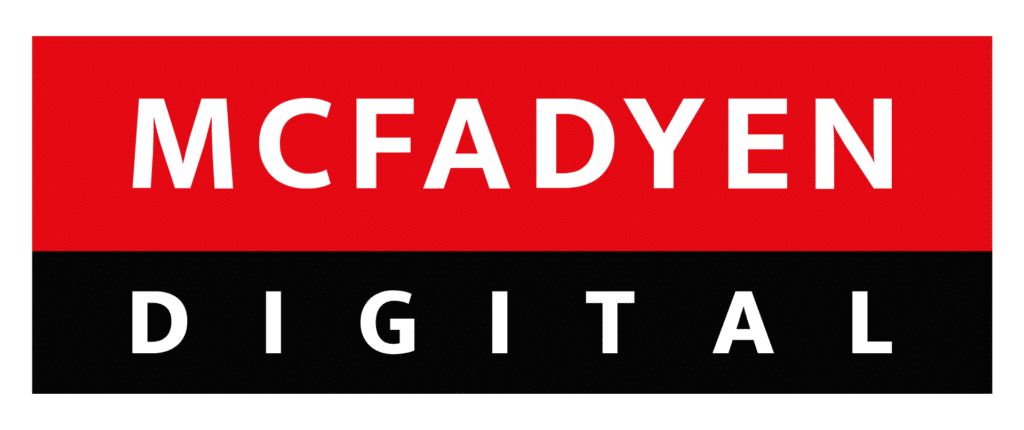
The retail landscape for retail digital is constantly shifting, with consumer expectations higher than ever, heightened by an increased reliance on digital shopping has taken hold in a post-pandemic world. According to a recent report by Forrester, companies that replatform every three to five years see a 30% increase in customer satisfaction and a 25% increase in conversion rates. This underscores the necessity for retailers to periodically evaluate and upgrade their ecommerce platforms to stay ahead of the curve.
Replatforming is more than just a technical upgrade; it’s a strategic move that can redefine the customer experience, streamline operations, and drive revenue growth. In this context, the approach known as composable commerce is gaining significant traction. Defined by the MACH (Microservices-based, API-first, Cloud-native, and Headless) Alliance, composable commerce offers a flexible, scalable, and future-proof solution for modern retail needs. McFadyen Digital, a founding member of the MACH Alliance, stands at the forefront of promoting and implementing this innovative approach.
Understanding Composable Commerce and the MACH Alliance

A visual representation of composable commerce MACH architecture courtesy of the MACH Alliance.
Composable commerce is an approach where the ecommerce platform is built using best-of-breed components that are integrated via APIs. This method allows retailers to select and combine various services and functionalities to create a customized solution tailored to their unique needs. The MACH Alliance sets the standards for this approach, emphasizing the use of microservices, APIs, cloud-native applications, and headless architecture to ensure flexibility, scalability, and agility.
Benefits of Composable Commerce
Flexibility and Customization: Retailers can choose the best components for their specific requirements, avoiding the limitations of monolithic systems.
Scalability: Easily scale individual components as needed without affecting the entire system.
Agility: Quickly adapt to market changes and consumer demands by swapping out or upgrading components seamlessly.
Innovation: Leverage cutting-edge technologies and services to stay competitive and meet evolving customer expectations.
Alternatives to Composable Commerce
While composable commerce offers significant advantages, it’s essential to consider other architecture options to understand why composable commerce stands out.
Monolithic Architecture
Monolithic systems are all-in-one solutions where the entire platform is built and maintained as a single unit. While this approach can be simpler to manage initially, it lacks flexibility and can be challenging to scale or modify. Upgrading or changing any part of a monolithic system often requires extensive rework, making it less agile and more costly over time.
Suite-based Solutions
Suite-based solutions like Adobe Commerce and Shopify provide a comprehensive set of features out of the box. These platforms offer robust functionalities and can be effective for many retailers. However, they can also be rigid, making it difficult to integrate third-party solutions or customize specific aspects of the platform. Despite this, suite-based solutions can still be part of a composable MACH technology stack, providing a blend of comprehensive features and modular flexibility.
Composable Commerce Platform Options
Several platforms are pioneering the composable commerce approach as members of the MACH Alliance. These platforms include:
BigCommerce: Providing a flexible and open SaaS platform, BigCommerce enables retailers to leverage a range of APIs and third-party integrations to create tailored solutions.
commercetools: Known for its robust API-first approach, commercetools offers a highly flexible and scalable solution that supports extensive customization and integration.
Marketplacer: A new member of the MACH Alliance as of Q2 2024, Marketplacer is an. enterprise-class SaaS marketplace platform especially strong in the retail space.
Mirakl: Specializing in marketplace solutions, Mirakl allows retailers to easily add marketplace functionality to their ecommerce platforms, enhancing product offerings and revenue streams.
VTEX: As a comprehensive commerce platform, VTEX supports a wide range of functionalities, including marketplace and drop ship capabilities, making it a versatile choice for retailers.
Incorporating Suite-based Solutions
Suite-based solutions like Adobe Commerce and Shopify can still play a role in a composable MACH stack. By integrating these platforms with best-of-breed components, retailers can enjoy the benefits of both worlds: comprehensive out-of-the-box features and the flexibility of a modular approach. The modern reality of most leading suite-based solutions, including the options referenced here, is that a robust and well-documented API layer make integrations within a composable technology stack possible.
Expansion Capabilities with Composable Commerce
One of the standout benefits of composable commerce is its ability to support rapid expansion and diversification. Retailers can easily add new features, channels, and functionalities to their platforms without the need for extensive rework. Organizations like the MACH Alliance can provide pre-vetted technology options that are frequently paired together in best-of-breed ecommerce stacks, but the options are truly unlimited.
Marketplace and Drop Ship Functionality
Adding marketplace and drop ship capabilities can significantly expand a retailer’s product offerings and revenue streams. According to a recent study by Digital Commerce 360, global marketplace sales are projected to reach $7.1 trillion by 2025, highlighting the immense growth potential in this area. Platforms like MACH Alliance members Marketplacer, Mirakl and VTEX, make it seamless to integrate third-party seller functionality into an existing ecommerce site. Pre-built connectors such as McFadyen Digital’s The Marketplace Connector, are built using MACH principles and can provide meaningful project acceleration when adding such capabilities to a traditional ecommerce model.
Diversifying Revenue Channels
Composable commerce allows retailers to quickly adapt to new market opportunities by adding new features and connectivity. Whether it’s integrating with new payment providers, launching new sales channels, or enhancing customer experiences with personalized content, the modular nature of composable commerce ensures retailers can stay agile and responsive.
Artificial Intelligence Integration
AI is becoming an integral part of the modern ecommerce experience, and composable commerce makes it easier to incorporate AI-driven features. Retailers are leveraging AI for various purposes, including:
Personalization: Companies like Amazon use AI to provide personalized product recommendations, leading to higher conversion rates and customer satisfaction.
Customer Service: AI-powered chatbots and virtual assistants, such as those used by H&M, enhance customer service by providing instant, 24/7 support.
Inventory Management: Retailers like Zara use AI to optimize inventory management, reducing costs and ensuring better product availability.
Conclusion
Replatforming a retail ecommerce site is a significant undertaking that can deliver substantial benefits when approached correctly. Composable commerce, as defined by the MACH Alliance, offers a flexible, scalable, and future-proof solution that empowers retailers to stay competitive in a rapidly changing market. By leveraging the strengths of best-of-breed components and integrating them seamlessly, retailers can create customized, innovative, and responsive ecommerce platforms.
For retailers seeking to capitalize on these trends and drive future growth, McFadyen Digital offers unparalleled expertise in ecommerce and marketplace solutions. Contact us at info@mcfadyen.com to learn more.
Sources:
- Forrester Report on Replatforming Benefits
- Digital Commerce 360 Study on Marketplace Growth
- Real-world examples from Amazon, H&M, and Zara
Related Articles
Turn Insight Into Impact.
Start Today.




